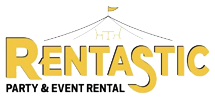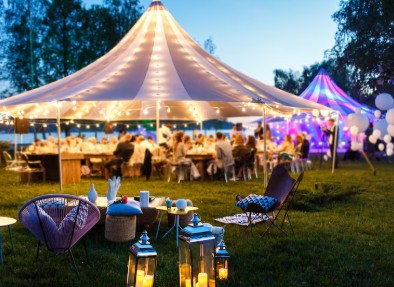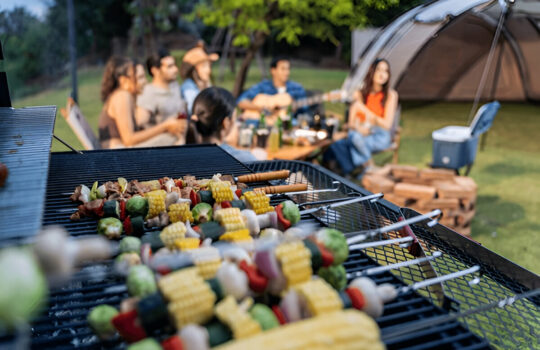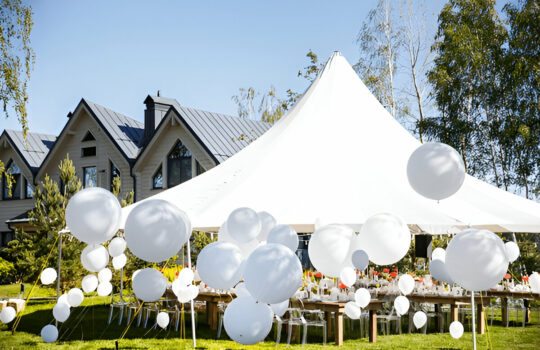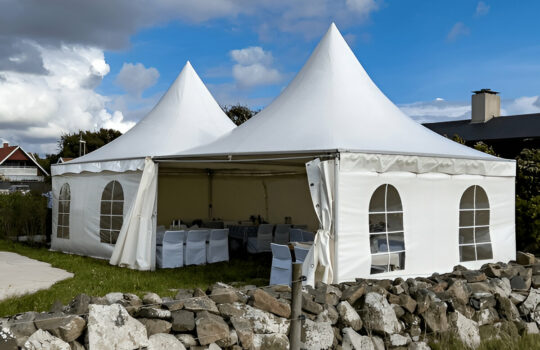Tent Rentals: Enhance the Fan Experience at Big Events
November 25, 2024 2024-11-25 7:33Tent Rentals: Enhance the Fan Experience at Big Events
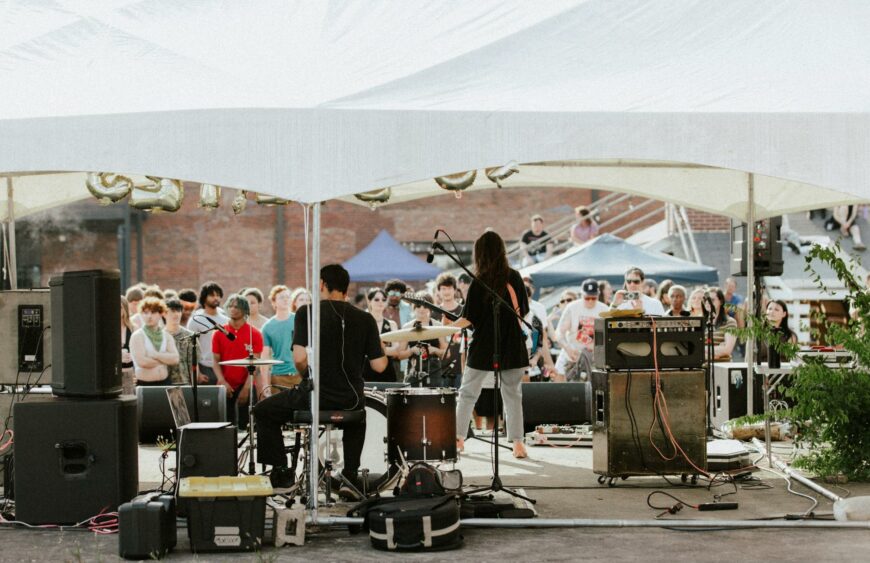
Tent Rentals: Enhance the Fan Experience at Big Events
Discover how tent rentals: enhance the fan experience at big events with style, comfort, and functionality.
Tent Rentals Overview
Tent rentals play a crucial role in enhancing the experience at large events, providing shelter and comfort to attendees. With various types of tents available, choosing the right style for the occasion is essential.
Tent Types and Styles
Tent rental companies offer a diverse selection of options tailored to different events. These include pole tents, frame tents, clear span structures, and more. Each type has its own unique characteristics that cater to various needs, from weddings and corporate gatherings to outdoor celebrations and music festivals [1].
Here is a breakdown of some popular tent types and their features:
| Tent Type | Description | Ideal Use |
|---|---|---|
| Pole Tents | Supported by center poles, creating a classic look with a peak. | Weddings, parties |
| Frame Tents | Frame-supported, allowing for flexible placement without center poles. | Corporate events, trade shows |
| Sailcloth Tents | Elegant and stylish, made from high-quality fabric that flows beautifully. | High-end events, receptions |
| Clear Span Tents | Sturdy structures with no interior poles, maximizing space. | Large gatherings, expos |
Understanding these options can help event planners select the best tent to enhance the guest experience and meet the event’s specific requirements.
Importance of Tent Anchoring
Securing a tent to the ground is a critical aspect of ensuring safety and stability. Tent anchoring refers to the methods used to fasten tents to the ground, using components like stakes, weights, and anchors. Proper anchoring prevents tents from being displaced by wind or adverse weather conditions, which is especially important in outdoor settings.
Different methods of anchoring are employed based on tent type and location. Here are some common anchoring options:
| Anchoring Method | Description | When to Use |
|---|---|---|
| Stakes | Long, pointed metal pieces driven into the ground. | Soft ground, lawns |
| Weights | Heavy objects placed on tent legs to secure them. | Hard surfaces, like pavement |
| Concrete Blocks | Heavy blocks added for additional stability. | Areas with high wind risks |
Using the right anchoring technique is vital for maintaining the integrity of the structure, ensuring that attendees can enjoy the event without safety concerns.
For more information about how tent rentals can be utilized effectively for events, check out our articles on why large tents work for trade shows and tent rentals for outdoor fundraisers: maximize space.
Factors Affecting Tent Rentals
When organizing a significant event or gathering, understanding the factors that influence tent rentals is essential. The two primary considerations that often come into play are pricing factors and the size and capacity of the tent.
Pricing Factors
The cost of renting a tent can vary significantly based on a multitude of factors. These may include the type of tent selected, size, required accessories, and additional services needed for setup and delivery. Couples organizing weddings can expect to spend between $425 and $1,000 for their wedding tent rentals, with costs per person ranging from $7.50 to $15 [2].
The table below outlines estimated costs associated with different sizes of tents:
| Tent Size | Capacity (Guests) | Estimated Rental Cost |
|---|---|---|
| 15×15 ft | Up to 20 | $140 |
| 20×30 ft | Up to 50 | $300 |
| 30×60 ft | Up to 150 | $750 |
| 40×80 ft | Up to 320 | $1,040 |
Factors influencing the overall pricing include:
- Tent type
- Size requirements
- Lighting options
- Flooring needs
- Accessories such as sidewalls and heating or cooling units
For specific applications, consulting articles on tent rentals for outdoor fundraisers (tent rentals for outdoor fundraisers: maximize space) or special corporate events can further clarify costs.
Size and Capacity Considerations
Choosing the appropriate tent size is crucial to ensure comfort for all event attendees. A tent must be large enough to accommodate not only guests but also any additional amenities such as seating, food service areas, and other facilities.
For example, a 40×80 feet tent can hold approximately 320 guests, while a smaller 15×15 feet tent is suited for about 20 individuals.
When planning an event, it’s important to assess the expected attendance and select a tent size that allows for adequate space. Consultants often recommend adding 10-20% additional space for extra comfort. Event planners might find that larger tents work particularly well for product demos, offering a professional touch, as in the article on large tents for product demos: a professional touch.
Always consider the venue’s layout and any restrictions that may affect tent placement when determining the size and capacity for your event tent.
Tent Features and Add-Ons
When it comes to enhancing the fan experience at big events, certain features and add-ons can make a significant difference. Among these, controlling temperature and utilizing block-out materials are crucial for ensuring a comfortable environment for attendees.
Controlling Temperature
Providing a temperature-controlled tent for outdoor events can greatly enhance guest comfort. Proper temperature regulation ensures that individuals attending the event are not too hot or too cold. This is especially critical during extremes of weather, whether it’s combating humidity on a hot day or protecting against rain or snow. By maintaining a comfortable atmosphere, the event can become more enjoyable and successful overall. Happy guests are likely to stay longer, enhancing their experience at the event [3].
| Temperature Control Features | Benefits |
|---|---|
| Portable heaters | Maintain warmth in cool conditions |
| Air conditioning units | Combat heat and humidity |
| Ventilation systems | Ensure proper air circulation and freshness |
Block-Out Material Advantages
Block-out material refers to fabric with light-blocking properties specifically designed to keep sunlight out and regulate heating and cooling within the tent. This type of material is particularly advantageous for daytime events, as it helps to create a more pleasing environment by reducing glare and preventing excessive heat buildup inside the tent [1].
Utilizing block-out materials offers:
| Block-Out Material Benefits | Description |
|---|---|
| Light control | Minimizes sunlight, reducing glare |
| Improved climate control | Helps maintain a stable temperature inside |
| Enhanced privacy | Reduces visibility from the outside |
Incorporating these features and add-ons can significantly elevate the overall experience for attendees at outdoor events. For more insights on using tents effectively, check out our guides on tent rentals for outdoor fundraisers: maximize space and tent rentals for construction sites: surprising benefits.
Tent Rental Costs
Tent rental costs can vary significantly based on various factors, especially when it comes to specific events like weddings. Understanding pricing can help individuals plan their budget effectively.
Wedding Tent Pricing
On average, couples in the U.S. spend between $425 and $1,000 on wedding tent rentals, with the cost per person typically ranging from $7.50 to $15. The price is influenced by several aspects such as tent size, style, and additional accessories. For instance, larger tents, like a 40×80 square feet tent that can hold up to 320 guests, may cost around $1,040 for one day, while a smaller 15×15 square feet tent accommodating up to 20 people is generally less expensive but may offer less reliability in some cases [2].
| Tent Size | Capacity | Estimated Cost |
|---|---|---|
| 15×15 ft | Up to 20 | $200 – $300 |
| 20×20 ft | Up to 40 | $400 – $600 |
| 30×60 ft | Up to 180 | $800 – $1,200 |
| 40×80 ft | Up to 320 | $1,040 |
Factors Influencing Costs
The cost of renting a wedding tent is influenced by several key factors, including:
- Tent Size: Larger tents accommodate more guests, directly affecting the rental price.
- Tent Type: Different styles of tents (e.g., pole, frame, or sailcloth) come with varying costs.
- Labor Costs: Setup and takedown fees can add to the overall expense.
- Delivery Fees: Costs associated with transporting the tent to the event location.
- Additional Services: Lighting, flooring, and accessories like heat or cooling options can further increase costs.
- Discounts: Some rental companies may offer discounts for off-peak events or multiple rentals.
When planning an event, especially a wedding, thorough research on pricing and factors influencing costs can help in making informed decisions about tent rentals. For additional insights on the benefits of large tents for events, consider reading about why large tents work for trade shows.
Popular Tent Types
Selecting the right tent type is essential for enhancing the fan experience at big events. There are several popular options available, each with unique characteristics and benefits.
Pole Tents
Pole tents are among the most sought-after for various occasions such as weddings, corporate events, and festivals. These tents feature high peaks and are supported by center poles, which gives them a distinctive appearance and allows for spacious interiors. However, these center poles can sometimes obstruct views, which is a consideration for those planning seating arrangements.
Below is a table showing common sizes and capacities for pole tents:
| Tent Size | Capacity (Seated) |
|---|---|
| 20’x20′ | 24 |
| 30’x30′ | 60 |
| 40’x60′ | 240 |
| 60’x120′ | 600 |
For more details on how large tents can work for specific events, visit our article on why large tents work for trade shows.
Sailcloth Tents
Sailcloth tents are known for their sculpted peaks and beautiful translucent fabric that lets in natural light. These tents are often preferred for daytime events, allowing guests to enjoy the sunlight while being sheltered. Sailcloth tents can be found in both pole and frame styles, with rounded ends and wooden poles providing additional support.
The aesthetic appeal of sailcloth tents makes them a popular choice for outdoor weddings, receptions, and other celebratory occasions. They come in various sizes to accommodate different guest capacities.
| Tent Size | Capacity (Seated) |
|---|---|
| 20’x30′ | 40 |
| 30’x40′ | 100 |
| 40’x80′ | 300 |
| 60’x100′ | 600 |
For more insights into optimizing space for outdoor events, see our article on tent rentals for outdoor fundraisers: maximize space.
Marquee Tents
Marquee tents are often associated with elegant summer events and outdoor weddings. Characterized by their gable ends supported by king poles and side poles, these tents create a distinct look suitable for various events. Their unique shape and spacious layout make them ideal for gatherings such as wedding receptions and festivals.
Marquee tents can be customized with sidewalls to provide additional weather protection or to enhance privacy.
| Tent Size | Capacity (Seated) |
|---|---|
| 30’x45′ | 150 |
| 40’x60′ | 300 |
| 50’x100′ | 600 |
| 60’x120′ | 1,200 |
For more information on using large tents for events like product demonstrations, check out our article on large tents for product demos: a professional touch.
Choosing the appropriate tent type not only adds to the visual appeal of an event but can also significantly enhance the overall experience for attendees.
Specialized Event Themes
When planning events, incorporating specialized themes can significantly enhance the overall experience. In New York, tent rentals can be tailored to reflect specific themes such as sustainability and wellness, making these gatherings more engaging and meaningful.
Sustainability Focus
Sustainability themes are gaining traction for corporate events as organizations seek to minimize their environmental impact. This focus includes eco-friendly practices and responsible resource usage. Tent rentals for sustainable events often utilize biodegradable materials, locally sourced food, and energy-efficient lighting options.
Additionally, decor and furniture made from recycled materials or sustainably sourced wood are critical for achieving a cohesive sustainability theme. Organizers should consider how their tent setups can align with eco-conscious values. This approach not only enhances the event’s appeal but also reflects positively on the brand’s commitment to the environment.
| Component | Sustainable Options |
|---|---|
| Tent Materials | Biodegradable, Recycled |
| Food | Locally Sourced, Organic |
| Lighting | LED, Solar-powered |
| Decor | Recycled Materials, Sustainably Sourced Wood |
For more details on utilizing large tents for effective space management, check out our article on tent rentals for outdoor fundraisers: maximize space.
Wellness and Health Themes
Wellness and health themes focus on promoting physical and mental well-being among attendees. These events might incorporate activities like yoga sessions or meditation workshops, alongside health-conscious food and beverage selections. Tent rentals play a vital role here, offering comfortable seating for relaxation areas and dedicated spaces for physical activities.
Event organizers should consider incorporating special equipment for wellness workshops, ensuring the environment fosters engagement and relaxation. This not only creates a unique experience but also promotes a culture of health and mindfulness.
| Component | Wellness Options |
|---|---|
| Activities | Yoga, Meditation Workshops |
| Seating | Comfortable Lounge Furniture |
| Food | Health-focused Menus |
| Tent Features | Outdoor Activity Spaces |
For insights on how to add a professional touch to product demonstrations, explore our article on large tents for product demos: a professional touch.
By focusing on specialized themes like sustainability and wellness, event organizers can create memorable experiences that resonate with attendees while also maximizing the utility of tent rentals.
